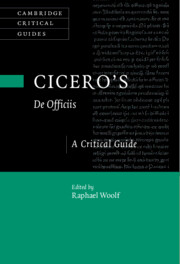Book contents
- Cicero’s De Officiis
- Cambridge Critical Guides
- Cicero’s De Officiis
- Copyright page
- Contents
- Contributors
- Acknowledgements
- Abbreviations
- Introduction
- Part I The Framework of De Officiis
- Part II The Role of Virtue
- 3 Oikeiōsis and the Origin of Virtue
- 4 Cicero’s Project in Book 2 of De Officiis
- 5 Cicero’s De Officiis on Practical Deliberation
- Part III Exemplary Ethics
- Part IV Self and Society
- Part V Politics
- References
- Index
- Cambridge Critical Guides
3 - Oikeiōsis and the Origin of Virtue
from Part II - The Role of Virtue
Published online by Cambridge University Press: 15 June 2023
- Cicero’s De Officiis
- Cambridge Critical Guides
- Cicero’s De Officiis
- Copyright page
- Contents
- Contributors
- Acknowledgements
- Abbreviations
- Introduction
- Part I The Framework of De Officiis
- Part II The Role of Virtue
- 3 Oikeiōsis and the Origin of Virtue
- 4 Cicero’s Project in Book 2 of De Officiis
- 5 Cicero’s De Officiis on Practical Deliberation
- Part III Exemplary Ethics
- Part IV Self and Society
- Part V Politics
- References
- Index
- Cambridge Critical Guides
Summary
In book 1.11-20 of De Officiis, Cicero draws on the work of Panaetius to give an account of how the most basic, in-built features of human nature provide a foundation for the cardinal virtues. His account begins from the basic drive for self-preservation which is the usual starting point for the canonical Stoic doctrine of oikeiōsis. The developments that Cicero claims follow from this fundamental starting point are, however, quite different from those which ensue on the other preserved accounts of oikeiōsis, such as that reported for Chrysippus in Diogenes Laërtius 7.85-86, the account in Cicero’s De Finibus 3.16-25 and the one in letter 121 of Seneca. It is also importantly different from the more complex account attributed to Posidonius by Galen in On the Doctrines of Plato and Hippocrates 5.5.8-9. By comparing and contrasting Cicero’s theory in the De Officiis with these other accounts, this chapter will explore important facets of Cicero’s philosophical method, his originality in adapting Panaetius’ theory to his own purposes, and the merits of the novel doctrine he embraced in his final philosophical work.
Keywords
- Type
- Chapter
- Information
- Cicero's ‘De Officiis'A Critical Guide, pp. 63 - 77Publisher: Cambridge University PressPrint publication year: 2023
- 1
- Cited by

